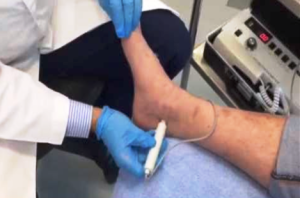Diabetic Foot Care
Diabetic foot care including Doppler Ultrasound assessment
Diabetes mellitus is a condition where the affected person has high blood sugar, either due to failure of insulin production in the Pancreas (Type 1) or because the cells in the body are resistant to insulin (Type 2).
National Diabetes Health Care Guidelines recommend people with diabetes have their feet checked by a podiatrist every 6-12 months.
Podiatrists are one of the essential professions within diabetic care, and have an important role to play in preventing and managing foot complications amongst people with diabetes. Feet can be greatly affected by diabetes and should be monitored regularly for any changes. Diabetic patients are at risk of decreased blood flow to their feet as well as peripheral neuropathy (loss of nerve sensation) to their feet.
How diabetes affects your feet?
- Diabetes can cause nerve damage (numbness, pins/needles) on your feet known as peripheral neuropathy.
- Diabetes can affect the circulation in the feet. Poor circulation means that your body’s normal response to healing is reduced.
- People with diabetes are more prone to foot infections.
- Diabetes complications can lead to foot ulcers and amputations.
- Diabetes can affect joints, muscles, tendons and ligaments causing them to change making them stiffer.
Treatment/Management
At Sydney Foot Clinic we will perform comprehensive annual foot assessments (more regularly if required) to determine any risk factors and ensure your feet are in good health. The diabetic assessment involve;
- Multiple neurological (nerve sensation) assessments. A non-invasive and painless assessment of the nerve sensation in the feet.
- Circulation testing – checking the arterial circulation (pulses) in the feet – if needed a Doppler ultrasound will be used to help assess the circulation.
- Skin and nail care.
- Gait analysis – watching the way you walk if needed.
Further to the assessment, footwear education will also be given ensuring the most comfortable, protective yet safest shoe is selected for you. The podiatrist will also cut the toenails, remove and debride any corns or calluses if necessary.
Note
Due to an increase risk of foot complications in the feet, diabetics are often advised to get their toenails cut by a podiatrist. Whilst not all diabetics need their nails cut, those at risk of circulation problems, loss of feeling in their feet, eye site problems or a decrease in flexibility are often advised to see a podiatrist.
Failure of wound healing or ulcers on your feet can occur if you have diabetes and have associated complications including changes to the blood flow. This risk is significantly higher if your blood glucose control is poor, and healing these can be very challenging.
If you have diabetes and suffer from any foot complaints or want a podiatric assessment contact Sydney Foot Clinic.


